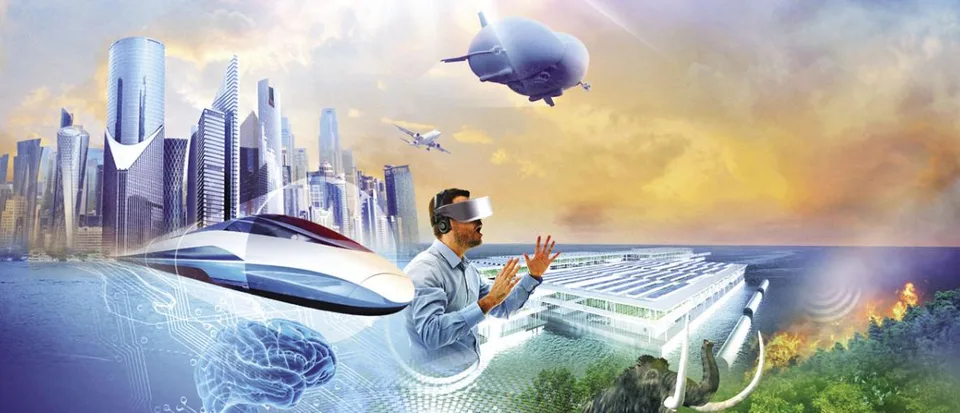
Not a fan of Windows 11—how to set it up to work more like Windows 10.
September 28, 2022
U haul is struck by a data breach exposing customer data.
September 28, 2022The future is coming, and sooner than you think. These emerging technologies will change the way we live, how we look after our bodies and help us avert a climate disaster.
Whether you like it or not, technology is rapidly improving, offering new innovations and revolutionary projects every year. Some of the very sharpest minds are out there creating the next piece of future technology that will completely change how we live our lives. It can feel like scientific progress is steady but we have lived through a period of immense technological improvement in the last half century.
There are innovations happening right now that are ripped straight from the pages of science-fiction. Whether that is robots that can read minds, AI that can create images on their own, holograms, bionic eyes, or other mind-blowing technology, there is a lot to expect from the world of future technology. Below we’ve picked out some of the biggest and most interesting ideas.
Sand batteries
Not every technology bettering our future has to be complicated, some are simple, yet extremely effective.
One of these kind of technologies has come from some Finnish engineers who have found a way to turn sand into a giant battery.
These engineers piled 100 tons of sand into a 4 x 7 metre steel container. All of this sand was then heated up using wind and solar energy.
This heat can then be distributed by a local energy company to provide warmth to buildings in nearby areas. Energy can be stored this way for long periods of time.
All of this occurs through a concept known as resistive heating. This is where a material is heated by the friction of electrical currents.
Sand and any other non-super conductor are warmed by the electricity passing through them generated heat than can be used for energy.
Underwater gloves
Plenty of technological developments have come from copying the attributes of animals, and the ‘octa gloves’ are no exception.
Researchers at Virginia Tech have created underwater gloves that mimics the suction abilities of an octopus for a human hand.
The team behind these gloves re-imagined the way that an octopus’s suckers work. This design was created to perform the same function as said suckers, activating an attachment to objects with light pressure.
Through the use of these suckers and an array of micro-sensors, the suckers on the gloves are able to tighten and loosen to grip objects underwater without applying a crushing force.
This could be used in the future for rescue divers, underwater archaeologists, bridge engineers, salvage crews and other similar fields.
Xenotransplantation
Inserting the heart of a pig into a human feels like a bad idea, and yet, this is one of the latest medical procedures that is seeing rapid progress.
Xenotransplantation – the procedure of transplanting, implementing or infusing a human with cells, tissues or organs from an animal source – has the potential to revolutionise surgery.
One of the most common procedures performed so far is the insertion of a pig’s heart into a human. This has now successfully happened twice. However, one of the patients was only alive for a few months, and the second is still being observed.
In these surgeries, the heart cannot be instantly put into a human, gene-editing needs to take place first. Certain genes need to be knocked out of the heart and human genes need to be added, mainly around immune acceptance and genes to prevent excessive growth of heart tissue.
Right now, these surgeries are risky and there is no certainty around success. However, in the near future, we could see xenotransplants happening on a regular basis, providing hearts or tissues from animals to humans in need of it.
AI image-generation
As artificial intelligence continues to perform jobs just as well as humans, there is a new industry to add to the list – the world of art. Researchers at the company OpenAI have created a software that is able to create images from just worded prompts.
Type in ‘a dog wearing a cowboy hat singing in the rain’ and you’ll get a host of completely original images that fit that description. You can even choose what style of art your request will come back in. However, the technology isn’t perfected and still has issues, like when we gave it poor prompts on designing cartoon characters.
This technology known as Dall-E is now its second iteration and the team behind it plans to continue developing it further. In the future, we could see this technology used to create art exhibitions, for companies to get quick, original illustrations or of course, to revolutionise the way we create memes on the internet.
Brain reading robots
No longer a science fiction trope, the use of brain reading technology has improved hugely in recent years. One of the most interesting and practical uses we’ve seen tested so far comes from researchers at the Swiss Federal Institute of Technology Lausanne (EPFL).
Thanks to a machine-learning algorithm, a robot arm and a brain-computer interface, these researchers have managed to create a means for tetraplegic patients (those who can’t move their upper or lower body) to interact with the world.
In tests, the robot arm would perform simple tasks like moving around an obstacle. The algorithm would then interprets signals from the brain using an EEG cap and automatically determine when the arm had made a move that the brain considered incorrect, for example moving too close to the obstacle or going too fast.
Over time the algorithm can then adjust to the individuals preferences and brain signals. In the future this could lead to wheelchairs controlled by the brain or assistance machines for tetraplegic patients.
3D printed bones
3D printing is an industry promising everything from cheap house building through to affordable rugged armour, but one of the most interesting uses of the technology is the building of 3D printed bones.
The company Ossiform specialises in medical 3D printing, creating patient-specific replacements of different bones from tricalcium phosphate – a material with similar properties to human bones.
Using these 3D printed bones is surprisingly easy. A hospital can perform an MRI which is then sent to Ossiform who create a 3D model of the patient-specific implant that is needed. The surgeon accepts the design and then once it is printed, it can be used in surgery.
What is special about these 3D printed bones is that because of the use of tricalcium phosphate, the body will remodel the implants into vascularised bone. That means they will enable the full restoration of function that the bone it is replacing had. To achieve the best integration possible, the implants are of a porous structure and feature large pores and canals for cells to attach to and reform bone.
Realistic holographs
Holograms have been filling science fiction books, films and culture for years now, and while it does exist, it remains a difficult thing to achieve, especially on a large scale. However, a potential technology that could change this is holobricks.
Developed by researchers from the University of Cambridge and Disney Research, holobricks are a way of tiling together multiple holograms to produce a large, seamless 3D image.
The issue with most holographs right now is the amount of data that they require to make, especially when done on a large scale. A regular HD display for a 2D image takes about 3GB per second to generate. A hologram of a similar size and resolution would be nearer to 3TB per second which is a huge amount of data.
To combat this, holobricks would provide individual sections of one large holographic image, heavily reducing the amount of data needed. This could eventually lead to the use of holograms in daily consumer entertainment like movies, games and digital displays.
Clothes that can hear
Wearable technology has come leaps and bounds over the years, adding new functionalities to the accessories and clothes we wear day to day. One promising avenue involves giving clothes ears, or at least the same capacity as an ear.
Researchers at MIT have created a fabric that is able to detect a heartbeat, handclaps or even very faint sounds. The team suggested that this could be used wearable tech for the blind, used in buildings to detect cracks or strains, or even woven into fishnets to detect the sound of fish.
For now, the material used is thick and a work in progress but they hope to roll it out for consumer use over the next few years.
Lab-made dairy products
You’ve heard of cultured “meat” and Wagyu steaks grown cell by cell in a laboratory, but what about other animal-based foodstuffs? A growing number of biotech companies around the world are investigating lab-made dairy, including milk, ice-cream, cheese and eggs. And more than one think they’ve cracked it.
The dairy industry is not environmentally friendly, not even close. It’s responsible for 4 per cent of the world’s carbon emissions, more than air travel and shipping combined, and demand is growing for a greener splash to pour into our tea cups and cereal bowls.
Compared with meat, milk isn’t actually that difficult to create in a lab. Rather than grow it from stem cells, most researchers attempt to produce it in a process of fermentation, looking to produce the milk proteins whey and casein. Some products are already at market in the US, from companies such as Perfect Day, with ongoing work focused on reproducing the mouthfeel and nutritional benefits of regular cow’s milk.
Beyond that, researchers are working on lab-produced mozzarella that melts perfectly on top of a pizza, as well other cheeses and ice-cream.
Hydrogen planes
Carbon emissions are a huge concern when it comes to commercial flights, but there is a potential solution and it has received a lot of funding.
A £15 million UK project has unveiled plans for a hydrogen-powered plane. This project is known as Fly Zero and is being led by the Aerospace Technology Institute in conjunction with the UK government.
The project has come up with a concept for a mid-size plane powered completely by liquid hydrogen. It would have the capacity to fly roughly 279 passengers halfway around the world without stopping.
If this technology could be actualised, it could mean a zero-carbon flight with no stops between London and Western America or London to New Zealand with a single stop.
Digital “twins” that track your health
In Star Trek, where many of our ideas of future technology germinated, human beings can walk into the medbay and have their entire body digitally scanned for signs of illness and injury. Doing that in real life would, say the makers of Q Bio, improve health outcomes and alleviate the load on doctors at the same time.
The US company has built a scanner that will measure hundreds of biomarkers in around an hour, from hormone levels to the fat building up in your liver to the markers of inflammation or any number of cancers. It intends to use this data to produce a 3D digital avatar of a patient’s body – known as a digital twin – that can be tracked over time and updated with each new scan.
Q Bio CEO Jeff Kaditz hopes it will lead to a new era of preventative, personalised medicine in which the vast amounts of data collected not only help doctors prioritise which patients need to be seen most urgently, but also to develop more sophisticated ways of diagnosing illness. Read an interview with him here.
Direct air capture
Through the process of photosynthesis, trees have remained one of the best ways to reduce the levels of CO2 in the atmosphere. However, new technology could perform the same role as trees, absorbing carbon dioxide at greater levels while also taking up less land.
This technology is known as Direct Air Capture (DAC). It involves taking carbon dioxide from the air and either storing the CO2 in deep geological caves under ground, or using it in combination with hydrogen to produce synthetic fuels.
While this technology has great potential, it has a lot of complications right now. There are now direct air capture facilities up and running, but the current models require a huge amount of energy to run. If the energy levels can be reduced in the future, DAC could prove to be one of the best technological advances for the future of the environment.
Green funerals
Sustainable living is becoming a priority for individuals squaring up to the realities of the climate crisis, but what about eco-friendly dying? Death tends to be a carbon-heavy process, one last stamp of our ecological footprint. The average cremation reportedly releases 400kg of carbon dioxide into the atmosphere, for example. So what’s a greener way to go?
In Washington State in the US, you could be composted instead. Bodies are laid in chambers with bark, soil, straw and other compounds that promote natural decomposition. Within 30 days, your body is reduced to soil that can be returned to a garden or woodland. Recompose, the company behind the process, claims it uses an eighth of the carbon dioxide of a cremation.
An alternative technology uses fungi. In 2019, the late actor Luke Perry was buried in a bespoke “mushroom suit” designed by a start-up called Coeio. The company claims its suit, made with mushrooms and other microorganisms that aid decomposition and neutralise toxins that are realised when a body usually decays.
Most alternative ways of disposing of our bodies after death are not based on new technology; they’re just waiting for societal acceptance to catch up. Another example is alkaline hydrolysis, which involves breaking the body down into its chemical components over a six-hour process in a pressurised chamber. It’s legal in a number of US states and uses fewer emissions compared with more traditional methods.
Artificial eyes
Bionic eyes have been a mainstay of science fiction for decades, but now real-world research is beginning to catch up with far-sighted storytellers. A raft of technologies is coming to market that restore sight to people with different kinds of vision impairment.
In January 2021, Israeli surgeons implanted the world’s first artificial cornea into a bilaterally blind, 78-year-old man. When his bandages were removed, the patient could read and recognise family members immediately. The implant also fuses naturally to human tissue without the recipient’s body rejecting it.
Likewise in 2020, Belgian scientists developed an artificial iris fitted to smart contact lenses that correct a number of vision disorders. And scientists are even working on wireless brain implants that bypass the eyes altogether.
Researchers at Montash University in Australia are working on trials for a system whereby users wear a pair of glasses fitted with a camera. This sends data directly to the implant, which sits on the surface of the brain and gives the user a rudimentary sense of sight.
Energy storing bricks
Scientists have found a way to store energy in the red bricks that are used to build houses.
Researchers led by Washington University in St Louis, in Missouri, US, have developed a method that can turn the cheap and widely available building material into “smart bricks” that can store energy like a battery.
Although the research is still in the proof-of-concept stage, the scientists claim that walls made of these bricks “could store a substantial amount of energy” and can “be recharged hundreds of thousands of times within an hour”.
The researchers developed a method to convert red bricks into a type of energy storage device called a supercapacitor.
This involved putting a conducting coating, known as Pedot, onto brick samples, which then seeped through the fired bricks’ porous structure, converting them into “energy storing electrodes”.
Iron oxide, which is the red pigment in the bricks, helped with the process, the researchers said.
Sweat powered smartwatches
Engineers at the University of Glasgow have developed a new type of flexible supercapacitor, which stores energy, replacing the electrolytes found in conventional batteries with sweat.
It can be fully charged with as little as 20 microlitres of fluid and is robust enough to survive 4,000 cycles of the types of flexes and bends it might encounter in use.
The device works by coating polyester cellulose cloth in a thin layer of a polymer, which acts as the supercapacitor’s electrode.
As the cloth absorbs its wearer’s sweat, the positive and negative ions in the sweat interact with the polymer’s surface, creating an electrochemical reaction which generates energy.
“Conventional batteries are cheaper and more plentiful than ever before but they are often built using unsustainable materials which are harmful to the environment,” says Professor Ravinder Dahiya, head of the Bendable Electronics and Sensing Technologies (Best) group, based at the University of Glasgow’s James Watt School of Engineering.
“That makes them challenging to dispose of safely and potentially harmful in wearable devices, where a broken battery could spill toxic fluids on to skin.
“What we’ve been able to do for the first time is show that human sweat provides a real opportunity to do away with those toxic materials entirely, with excellent charging and discharging performance.
Self-healing ‘living concrete’
Scientists have developed what they call living concrete by using sand, gel and bacteria.
Researchers said this building material has structural load-bearing function, is capable of self-healing and is more environmentally friendly than concrete – which is the second most-consumed material on Earth after water.
The team from the University of Colorado Boulder believe their work paves the way for future building structures that could “heal their own cracks, suck up dangerous toxins from the air or even glow on command”.
Living robots
Tiny hybrid robots made using stem cells from frog embryos could one day be used to swim around human bodies to specific areas requiring medicine, or to gather microplastic in the oceans.
“These are novel living machines,” said Joshua Bongard, a computer scientist and robotics expert at the University of Vermont, who co-developed the millimetre-wide bots, known as xenobots.
“They’re neither a traditional robot nor a known species of animal. It’s a new class of artefact: a living, programmable organism.”
Internet for everyone
We can’t seem to live without the internet (how else would you read sciencefocus.com?), but still only around half the world’s population is connected. There are many reasons for this, including economic and social reasons, but for some the internet just isn’t accessible because they have no connection.
Google is slowly trying to solve the problem using helium balloons to beam the internet to inaccessible areas, while Facebook has abandoned plans to do the same using drones, which means companies like Hiber are stealing a march. They have taken a different approach by launching their own network of shoebox-sized microsatellites into low Earth orbit, which wake up a modem plugged into your computer or device when it flies over and delivers your data.
Their satellites orbit the Earth 16 times a day and are already being used by organisations like The British Antarctic Survey to provide internet access to very extreme of our planet.
Source: https://www.sciencefocus.com/future-technology/future-technology-22-ideas-about-to-change-our-world/




